joelchan's working notes
Powered by 🌱Roam Garden@sanerAnalogiesOutBlue1999 for [[QUE - How might domain distance modulate the effects of analogies on creative output?]] | TLDR: infrequent mentions of far analogies amongst psychology labs, basically no actual use for reasoning in lab group meetings during actual working out of discovery, but did use in colloquia when presenting more finished work
General notes
References for main examples of analogy in science: far! Far! Far! Atom and solar system! Benzene and snake!
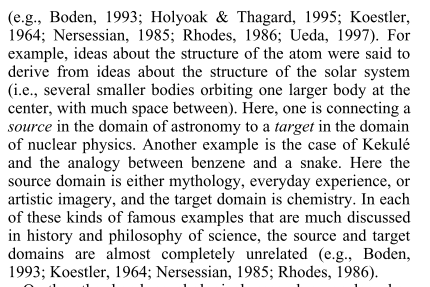 (p. 1)
(p. 1)
Some pointers here for [[QUE - What factors control whether people appropriately benefit from analogies (especially far-field ones) during creative problem solving?]]: domain-expertise! @novickAnalogicalTransferProblem1988: students with greater math expertise were better able to make analogies from math problems to other domains
 (p. 2)
(p. 2)
Similar to Dunbar's claim that [[CLM - far analogies are systematically overrated in their importance for creative breakthroughs due to memory bias - @dunbarHowScientistsThink1997]]: here we consider the possibility that the historical record is misleading
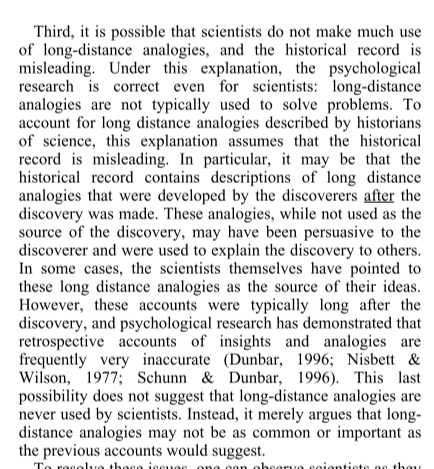 (p. 2)
(p. 2)
important to note here that there is a strong connection to research on the varying *functions* of analogy: sometimes for explanation and persuasion, and not for... actual problem solving? e.g., via direct transfer, influencing problem formulation, etc.
Method
very similar to @dunbarHowScientistsThink1997's m/s/In vivo method
sample: three ~70-90 min colloquia sessions (one speaker + ~30-60 audience members from department; all 3 speakers were senior researchers, well-known, two from other universities) in social psych, cognitive psych, and cognitive neuropsych + five ~70-90 min lab group meetings from two different lab groups (one in developmental psych with 10 scientists: two faculty, three postdocs, three graduate students, and two research assistants; one in cognitive psych, with 19 scientists: three faculty, six postdocs, five graduate students, and five research assistants), all at major research university in North America
core contrast between lab group meetings vs. colloquia rests on assumption that lab group meetings are early/in-progress, vs. colloquia (late/finished, similar to historical record)
 (p. 2)
(p. 2)
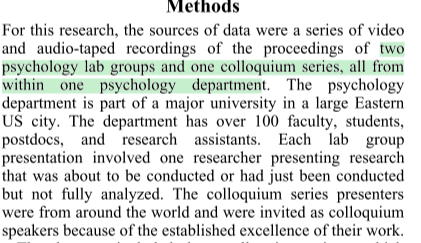 (p. 2)
(p. 2)
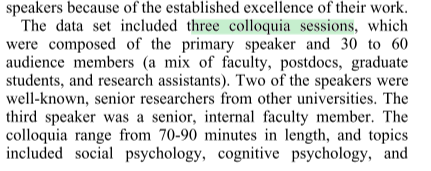 (p. 2)
(p. 2)
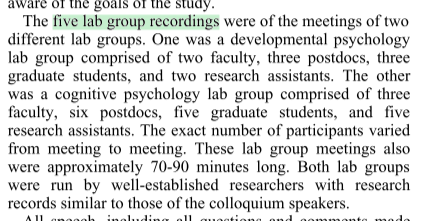 (p. 3)
(p. 3)
measures
measure: analogy yes/no - yes if compareing similarity/dissimilarity of two things in a structural or functional sense; no if x is attribute of y, or x is-a (instance of) y (e.g., "x is a connectionist system"). IRR is .90
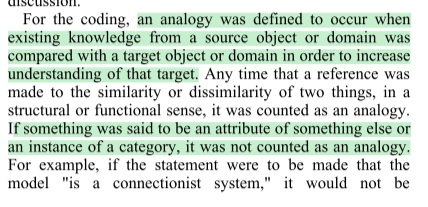
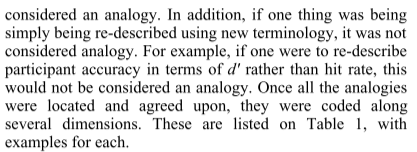 (p. 3)
(p. 3)
note: might leave out metaphors
measure: analogy within-domain vs. not (far analogies): domain is defined as psychology, bc couldn't reason through systematic way of distinguishing between domains?
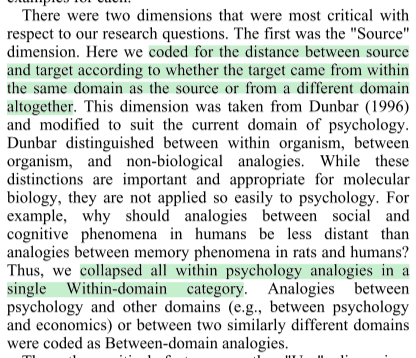
measure: analogy use vs. mere mention: use if analogy is used to illustrate or substantiate a point, or to draw a further inference; no if no followup to mention
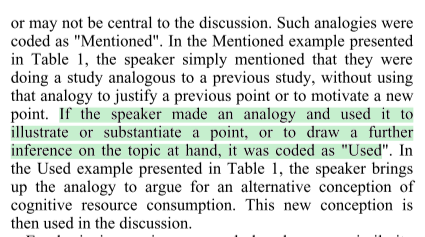 (p. 4)
(p. 4)
Results
Analogies were relatively frequent: ~3-15 in each lab group meeting, and ~4-15 in each colloquium
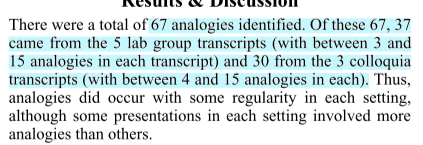 (p. 4)
(p. 4)
[[EVD - Far analogies were rare and never used in psychology lab group meetings for reasoning (vs. mere mentions); far analogies were rare in colloquia as well, but were frequently used for reasoning - @sanerAnalogiesOutBlue1999]]
Conclusions
Authors claim that these results (particularly the [contrast in use of far analogies]([[EVD - Far analogies were rare and never used in psychology lab group meetings for reasoning (vs. mere mentions); far analogies were rare in colloquia as well, but were frequently used for reasoning - @sanerAnalogiesOutBlue1999]]) between lab group meetings and colloqiua) support the claim that [[CLM - far analogies are systematically overrated in their importance for creative breakthroughs due to memory bias - @dunbarHowScientistsThink1997]]
I am not so sure, though! This rests on the assumption that no discovery and conceptual work is happening in colloquia. Only reasoning that happens in lab groups counts as real. Can see this as defensible for analogies from the presenter: in colloquia you're presenting fully formed work. And the "use" measure But what about analogies from the audience that are between-domain? Could those be generative in some way?
This study can't tease that out though. Could *maybe* look only at audience-generated between-domain analogies and see if there's anything going on there. But probably too small N to say anything. Could be an interesting case study though!
In general I think the shape is fine: generally low proportions of far analogies, and generally low proportions of those used in actual reasoning.